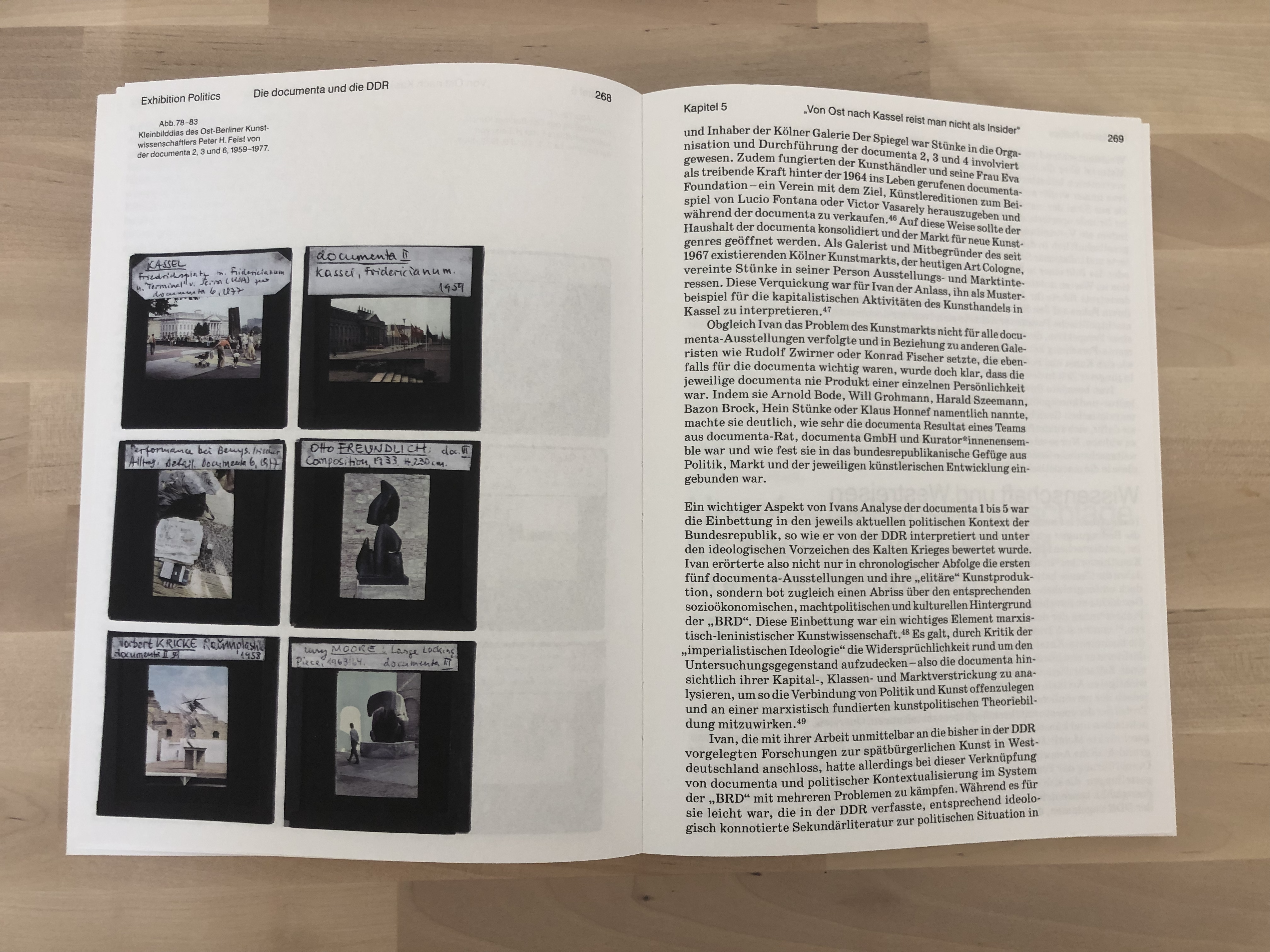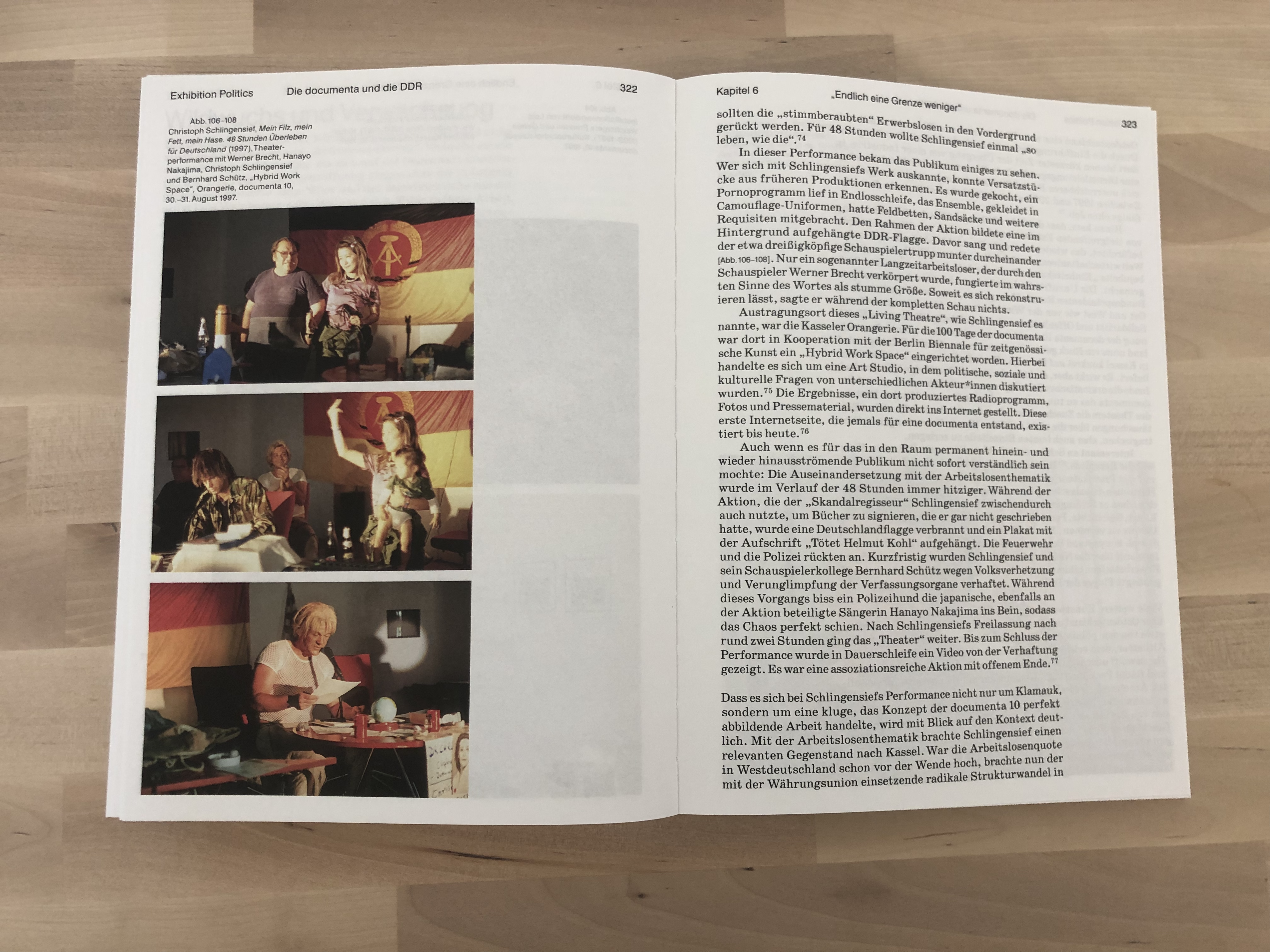FITA Magazine
Exhibition Politics. Die documenta und die DDR, by Alexia Pooth
Article by Francisca Gigante
![]()
Exhibition Politics. Die documenta und die DDR, Alexia Pooth, Kerber Culture, documenta archiv, 2024. [Photograph: FITA]
There are 6 chapters in the book “Exhibition Politics. Die documenta und die DDR” by Alexia Pooth, published in 2024 by Kerber Culture with documenta archiv. The 360-plus-page book is written in German, but is easy to read.
It begins with the first chapter on the “Eastern border situation” and the years when documenta was founded in the 1950s by Arnold Bode. There is a reference to Brecht before the doors: where the bourgeois circle of friends of documenta is reviewed. The second chapter deals with the idea of “human documenta”, i.e. documenta II in the sights of the GDR. In these pages we delve into Arnold Bode's exhibition project, documenta as a document of humanity, Hermann Raum and the documenta mbH institution, a letter from the train station restaurant and Gerhard Richter's intervention in documenta 2. The third chapter reflects on the invitations made in the history of documenta 5 and the hustle and bustle of the GDR during this mega-exhibition. It points out Kassel's attempts to get it accepted, the internal debates in East Berlin and the golden line of the film section of documenta 5, with artistic direction by Harald Szeemann.
Exhibition Politics. Die documenta und die DDR, by Alexia Pooth
Article by Francisca Gigante

Exhibition Politics. Die documenta und die DDR, Alexia Pooth, Kerber Culture, documenta archiv, 2024. [Photograph: FITA]
There are 6 chapters in the book “Exhibition Politics. Die documenta und die DDR” by Alexia Pooth, published in 2024 by Kerber Culture with documenta archiv. The 360-plus-page book is written in German, but is easy to read.
It begins with the first chapter on the “Eastern border situation” and the years when documenta was founded in the 1950s by Arnold Bode. There is a reference to Brecht before the doors: where the bourgeois circle of friends of documenta is reviewed. The second chapter deals with the idea of “human documenta”, i.e. documenta II in the sights of the GDR. In these pages we delve into Arnold Bode's exhibition project, documenta as a document of humanity, Hermann Raum and the documenta mbH institution, a letter from the train station restaurant and Gerhard Richter's intervention in documenta 2. The third chapter reflects on the invitations made in the history of documenta 5 and the hustle and bustle of the GDR during this mega-exhibition. It points out Kassel's attempts to get it accepted, the internal debates in East Berlin and the golden line of the film section of documenta 5, with artistic direction by Harald Szeemann.
In the fourth chapter, we see a success in cultural policy with the presence of the GDR in Kassel in 1977. This was to be a new territory for everyone, as we read “Neuland für alle!”. The next section contains facts, memories and context, presented in dialogue through interviews conducted by the author Alexia Pooth with the journalist Eduard Beaucamp (b. 1937); the artist Klaus Honnef (b. 1939); the politician and former German Finance Minister and former Minister President of Hesse, Hans Eichel (b. 1941); stage director, painter and theater director Achim Freyer (b. 1934); artist Gudrun Brüne-Heisig (b. 1941); artist Volker Stelzmann (b. 1940), historian and professor Gabi Dolff-Bonekämper (b. 1952); art historian, researcher and curator Gabriela Ivan (b. 1951); and gallery owner and journalist Jürgen Schweinebraden Freiherr von Wichmann-Eichhorn (1938-2022).
The fifth chapter refers to the journey from the East to Kassel, explaining why it is not for the initiated. In these pages we look at the editions of documenta 7 (Rudi Fuchs) and documenta 8 (Manfred Schneckenburger) in the 1980s. The sixth and final chapter deals with documenta after the fall of the Berlin Wall, which finally celebrates one less border in the circumscribed space of post-1989 Europe. It is spread over several sections that recall the 24-studen-aktion in documenta 9 (Jan Hoet), the 2nd Weimer lecture marathon, documenta 10 and politics (Catherine David) and, finally, the enormous political potential of contemporary art from the 1990s onwards.
Between the chapters we get a better understanding of the frameworks through the words of German artists such as Gerhard Altenbourg, HAP Grieshaber, John Heartfield, A.R. Penck, Werner Tübke, Klaus Stack, Via and Pina Lewandowsky and Yana Milev. Perhaps it would have been culturally diverse and interesting to add the perspective of migrant artists exhibiting at documenta from outside Germany.
All in all, this publication is an enormous help in starting debates about the value of the large-scale exhibitions that began in the city of Kassel in the GDR. It serves as a living testimony, with archive material including correspondence and images of works of art, for historians, researchers, politicians and artists to look at the art history of documenta in its first 50 years of existence, between 1950 and 2000.
![]()
![]()
![]()
![]()
![]()
![]()
Exhibition Politics. Die documenta und die DDR, Alexia Pooth, Kerber Culture, documenta archiv, 2024. [Photographs: FITA]
The fifth chapter refers to the journey from the East to Kassel, explaining why it is not for the initiated. In these pages we look at the editions of documenta 7 (Rudi Fuchs) and documenta 8 (Manfred Schneckenburger) in the 1980s. The sixth and final chapter deals with documenta after the fall of the Berlin Wall, which finally celebrates one less border in the circumscribed space of post-1989 Europe. It is spread over several sections that recall the 24-studen-aktion in documenta 9 (Jan Hoet), the 2nd Weimer lecture marathon, documenta 10 and politics (Catherine David) and, finally, the enormous political potential of contemporary art from the 1990s onwards.
Between the chapters we get a better understanding of the frameworks through the words of German artists such as Gerhard Altenbourg, HAP Grieshaber, John Heartfield, A.R. Penck, Werner Tübke, Klaus Stack, Via and Pina Lewandowsky and Yana Milev. Perhaps it would have been culturally diverse and interesting to add the perspective of migrant artists exhibiting at documenta from outside Germany.
All in all, this publication is an enormous help in starting debates about the value of the large-scale exhibitions that began in the city of Kassel in the GDR. It serves as a living testimony, with archive material including correspondence and images of works of art, for historians, researchers, politicians and artists to look at the art history of documenta in its first 50 years of existence, between 1950 and 2000.






Exhibition Politics. Die documenta und die DDR, Alexia Pooth, Kerber Culture, documenta archiv, 2024. [Photographs: FITA]

